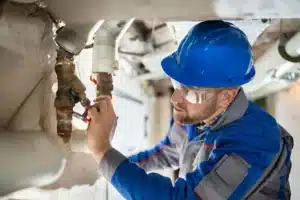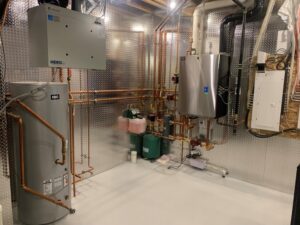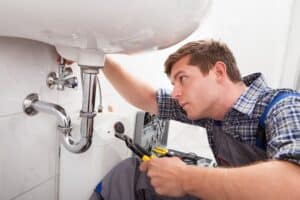Maybe the lifespan of your water heater has come to its end or you are renovating and want a more energy-efficient home. Whatever the reasons, when it’s time to replace your old water heater, you want to make sure you pick the right one.
According to Natural Resources Canada, the average Canadian uses upwards of 75 Litres of hot water a day. An average Canadian household will use upwards of 225 L. Water heating alone, is accountable for 15-25% of the energy used in a home.
When it comes to water heaters, there are various options available. Two of the most popular choices are the tankless or traditional storage-tank water heater. While they both provide hot water as needed, there are many differences between the two to consider first.
Table of Contents
ToggleHow do storage water tanks work?
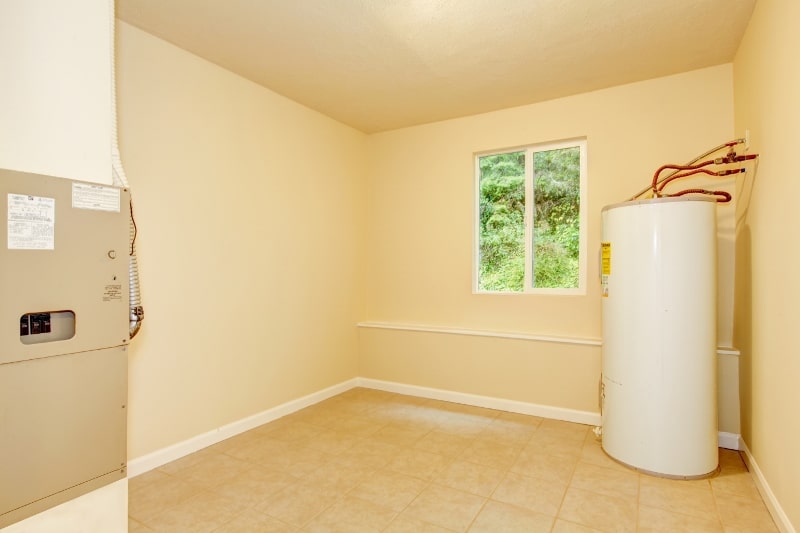
Traditional hot water tanks, or storage water heaters, hold a certain amount of water that is constantly kept heated. In a hot water tank, the amount of water stored is dependent on the size of the tank. Typically, a water tank can store between 20- to 80-gallons of water. When you turn on the hot water tap, hot water is drawn from the top of the water tank. Cold water then flows in to replace the water and is heated up.
There are two additional valves on the tank—the temperature and pressure-relief valve. These are for safety and open if temperatures become too hot or pressure builds too much. By releasing water and pressure, it ensures your tank doesn’t explode. Storage water tanks have a lifespan of between 8-12 years before they need to be replaced.
Because of the limitation of how much water the tank holds, there may be times when the hot water is completely used up. Larger families with a small water tank may experience this during high water demand periods. The tank will eventually refill and reheat, but it may take an hour to do so.
Maintenance: Twice a year maintenance should be done on the tank to flush out any sediment or mineral build-up. Since the tanks constantly hold hot water, letting any build-up occur can create issues with rust or corrosion.
Storage tank fuel types
Depending on the type of tank, different types of fuel will be used to heat the water. Different fuels will also vary differently in expense:
Electric: Electric heaters require no ventilation and are quickly and easily installed almost anywhere in a home. The water is heated by large coils that hang into the tank and heat the water, similar to electric oven coils. They are higher in energy efficiency but are more expensive to run than gas.
Gas: Gas-fueled water tanks are less expensive to run and are typically run using natural gas. For safety reasons, a gas water tank will need to have proper ventilation to release the toxic air released during combustion. A gas burner at the bottom of the tank is what is used to heat the water. Natural gas is more efficient to use but more expensive than electric heaters. Propane works the same as natural gas, however, it is usually only used when natural gas isn’t available in a home.
Solar: By using energy from the sun, solar heaters are virtually cost-free and highly energy-efficient. Solar collectors are attached to the roof, which then converts heat from the sun. The system includes collectors, circulating pumps, a storage tank, and controls. The upfront installation costs are significantly more.
With storage water tanks because the water inside is continuously being heated and maintained, there is constant energy being lost. This is known as standby heat loss and is a common problem. To help with this, water heaters can be bought with higher levels of insulation. This helps lessen the amount of standby heat loss which in turn helps save energy and money.
How do tankless water heaters work?
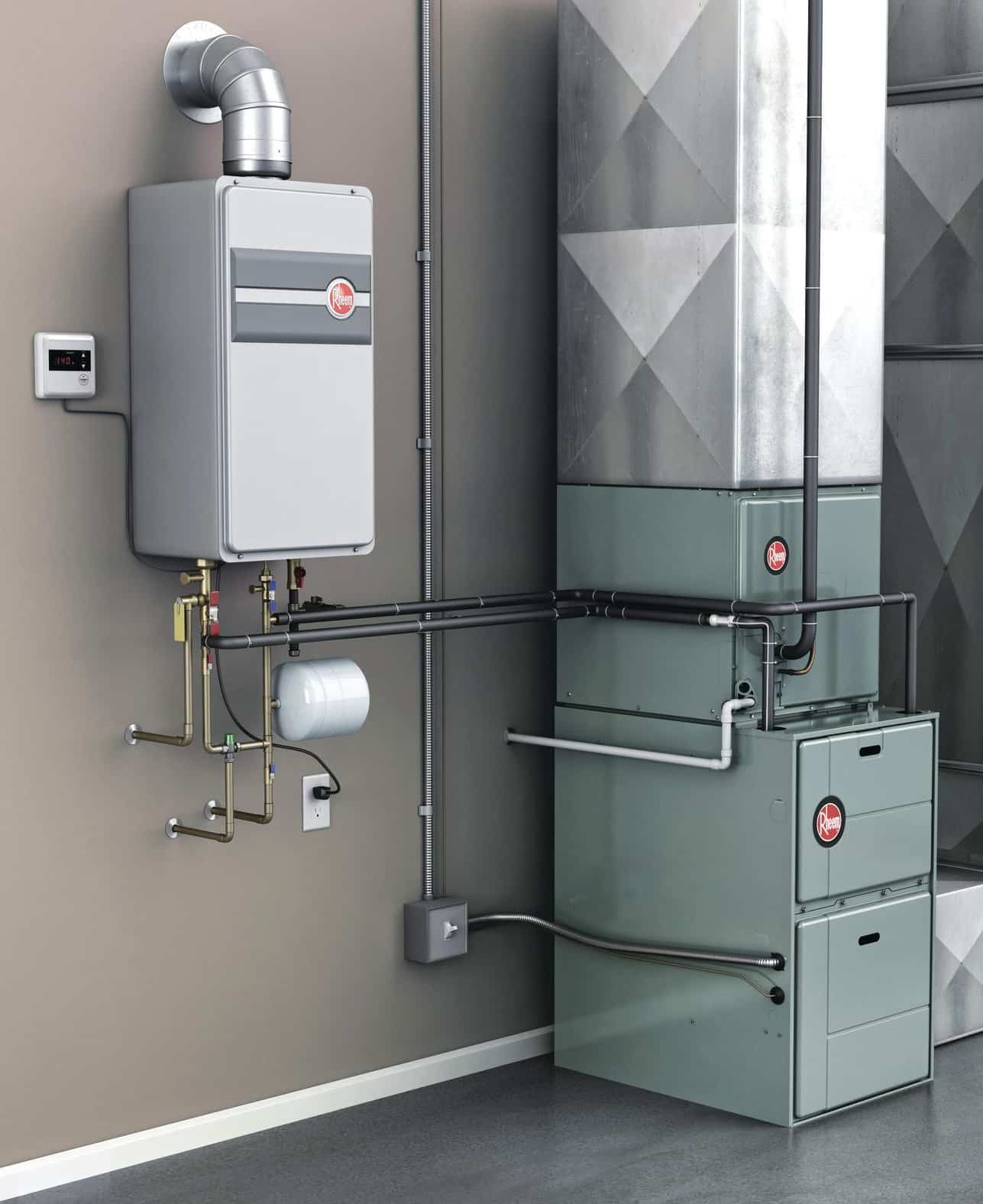
Tankless heaters can supply constant hot water but there is a limit to their output flow rate. A unit that is too small, will not be able to keep up with the water demands of a large family. The benefit of its compact size though is that it can easily be mounted on walls to free up floor space. Tankless water heaters also have a lifespan of upwards of 20 years, before they need replacing.
Maintenance: Similar to a storage water tank, tankless heaters need to be flushed of any residual minerals or sediment. Since the unit only holds water when needed, maintenance may be done only once a year. Water filters in the tanks should be changed regularly, ideally monthly, to protect against hard water damage.
Tankless fuel types
Similar to traditional hot water tanks, tankless heaters can use different fuel types to heat the water:
Electricity: Electric tankless heaters are much less expensive than gas and do not need ventilation. On the other hand, a large unit will require more electricity to run, which can increase monthly bills. During any power outages, it also won’t be able to supply hot water.
Gas: Similar to storage water heaters, a tankless heater can use either natural gas or propane as fuel. Non-condensing units are less expensive but will require ventilation to be installed. Condensing units, on the other hand, are more expensive and do not need ventilation.
Hot water is delivered at a rate of 4-8 gallons per minute, but there can be issues with simultaneous demands. Large water demands, such as showering and doing the laundry at the same time will run into problems with lukewarm water. Installing more than one tankless water heater can help with high-demand water usage.
Otherwise, installing a tankless water heater that is used only for one appliance is another solution. This is known as point-of-use, and allows high water demand appliance, such as dishwashers, to have their own supply.
Cost and process of installing a tankless vs hot water tank
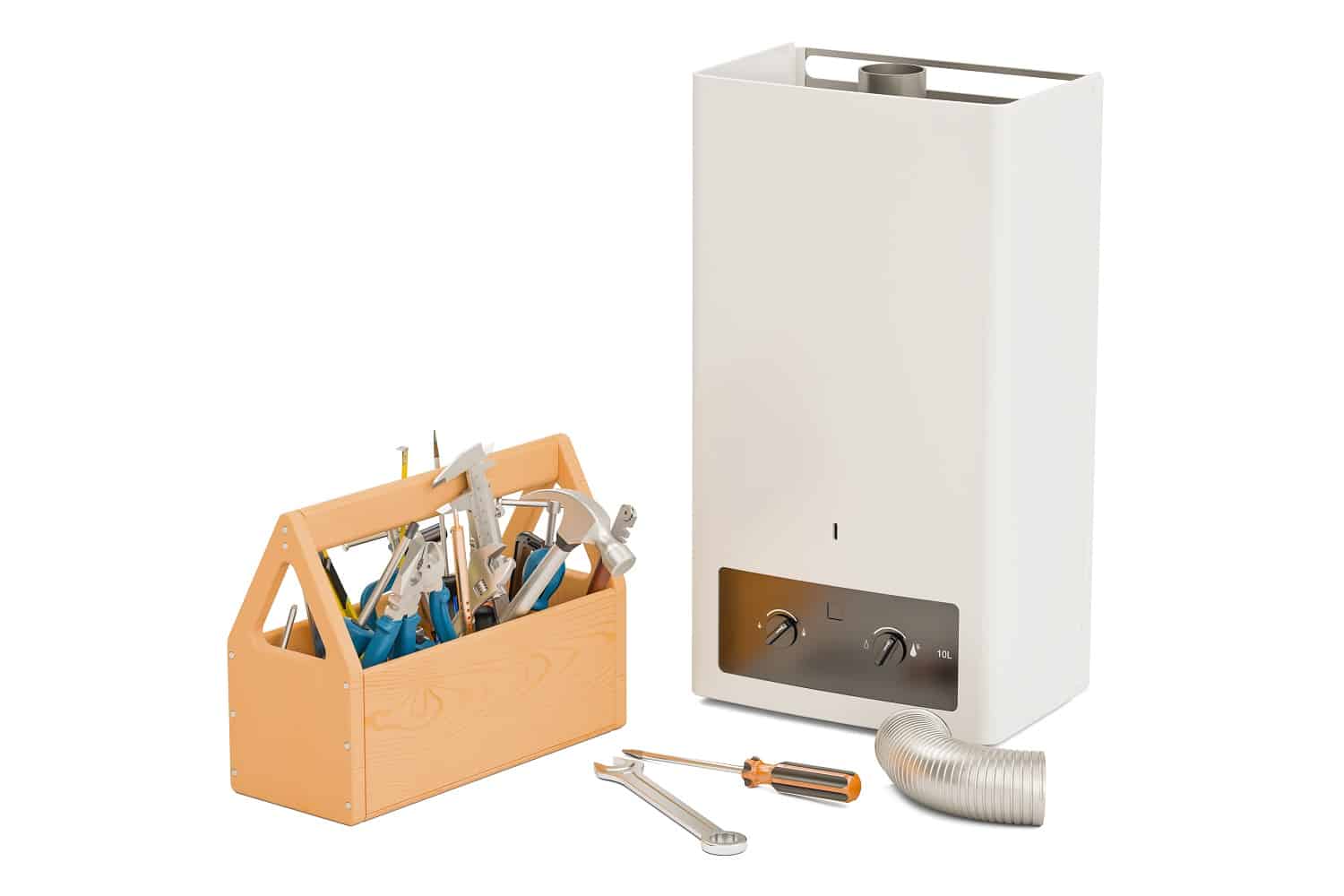
Beyond just picking a new water heater, it’s also important to understand the installation and costs involved in the decision. If you are just upgrading an old hot water tank with a new one, there is likely little involved in the process. If you are switching from a storage water heater to a tankless though, there is more involved.
Old storage water heaters will need to be removed first and the home retrofitted to accommodate a tankless unit. Gas tankless units may need larger gas lines and ventilation installed or modified. An electric tankless heater may need an electrician to improve the home’s electrical power.
Storage water tank
Storage water tanks are both quick and easy to install, with the whole process only taking a few hours at most. The tanks are installed indoors, either in the basement or inside a closet or garage. If the tank is a gas unit, proper ventilation will also need to be installed. Changing from a gas heater to an electric heater can be done without making major or expensive changes. Even though replacing an old tank with a newer one is simple, it’s still recommended to call a professional.
Cost of installing a storage water heater: Installation fees are split between the cost of the water heater and the cost of installation. The average cost for a 40- or 50-gallon water tank is about $1,000. Depending on the rate charged by your plumber per hour, the installation fee will be between $45 to $150 per hour. A storage water heater will typically take between 2 to 3 hours to install.
HomeAdvisors estimated average cost for both product and installation: $769 and $1,447
Tankless
Upgrading from a traditional to a tankless water heater requires a slightly more complicated installation. The initial upfront cost and installation of a tankless water heater are also much more expensive than a storage tank. Tankless water heaters will require significantly more BTUs as well when heating water. Gas tankless heaters require between 150,000 to 200,000 BTUs. Similarly, electric heaters will require high voltage, which may mean an upgrade to your home’s system.
Tankless heaters can be mounted on walls, but they still need to be within 50 feet of a power source. Outdoor tankless units can be installed outside the house and are built to endure various climates. Because of the experience required and complicated process to install a tankless system, it is highly recommended to call a professional.
Cost of installing a tankless water heater: Installation fees for a tankless are split between the cost of the unit, the installation and any necessary home retrofitting. Depending on the model, a tankless unit can cost between $300 to $1100. Installation time can take upwards of 10 hours to complete, so costs range between $500 to $1600. Additional expenses may come up if extra retrofitting is required. Such expenses would include installing ventilation pipes or increasing your homes’ electrical power.
HomeAdvisors estimated average cost for both product and installation: $1,013 – $2,954
What are some signs it’s time to replace your water tank?
It’s easy to forget about replacing your water tank when everything is working as it should. Regular maintenance and checks will help cover any minor repairs; however, it will eventually need a full replacement. If you aren’t sure about your water heater, it’s always better to know the signs now, rather than when something goes seriously wrong.
Your hot water tank is over 8-12 years old
With the average lifespan of a water tank running between 8-12 years, not replacing an old heater is a common mistake. After all, if your water heater is still working, why replace it? With storage water tanks, in particular, they work and store hot water 24 hours a day, 365 days a year. So, while 8-12 years may seem short, eventually, the wear and tear will mean it needs replacing. If you can’t remember the last time your water tank was replaced, it’s probably time to take a look.
Discoloured or rusty water
If your hot water is coming out discoloured, it’s a likely indicator there is a problem with your tank. Depending on the age of your tank, it may just mean your heater needs to be flushed. Since there is always hot water sitting in the tank, sediment and minerals can build up and cause corrosion. A routine maintenance check will flush the tank and typically fix the problem if the build-up is the cause. If your tank is creeping up in age though, it’s likely a sign that the tank simply needs to be replaced. If both your hot and cold water is discoloured, it may be a sign of a more serious plumbing problem.
You’re finding leaks in the tank
A leak is never something that you want to discover or have in your home. Unidentified leaks risk water damage and mould, as well as unwanted spikes in your monthly water bills. Even small leaks of one drip per second mean an added $1.00 per month. Depending on the type of leaks, smaller ones can be easily repaired. If the leaks continue to happen though, it may just be time for a new heater. In worst-case scenarios, a complete water heater failure can cause massive and costly flooding.
Things to consider when choosing tankless vs storage
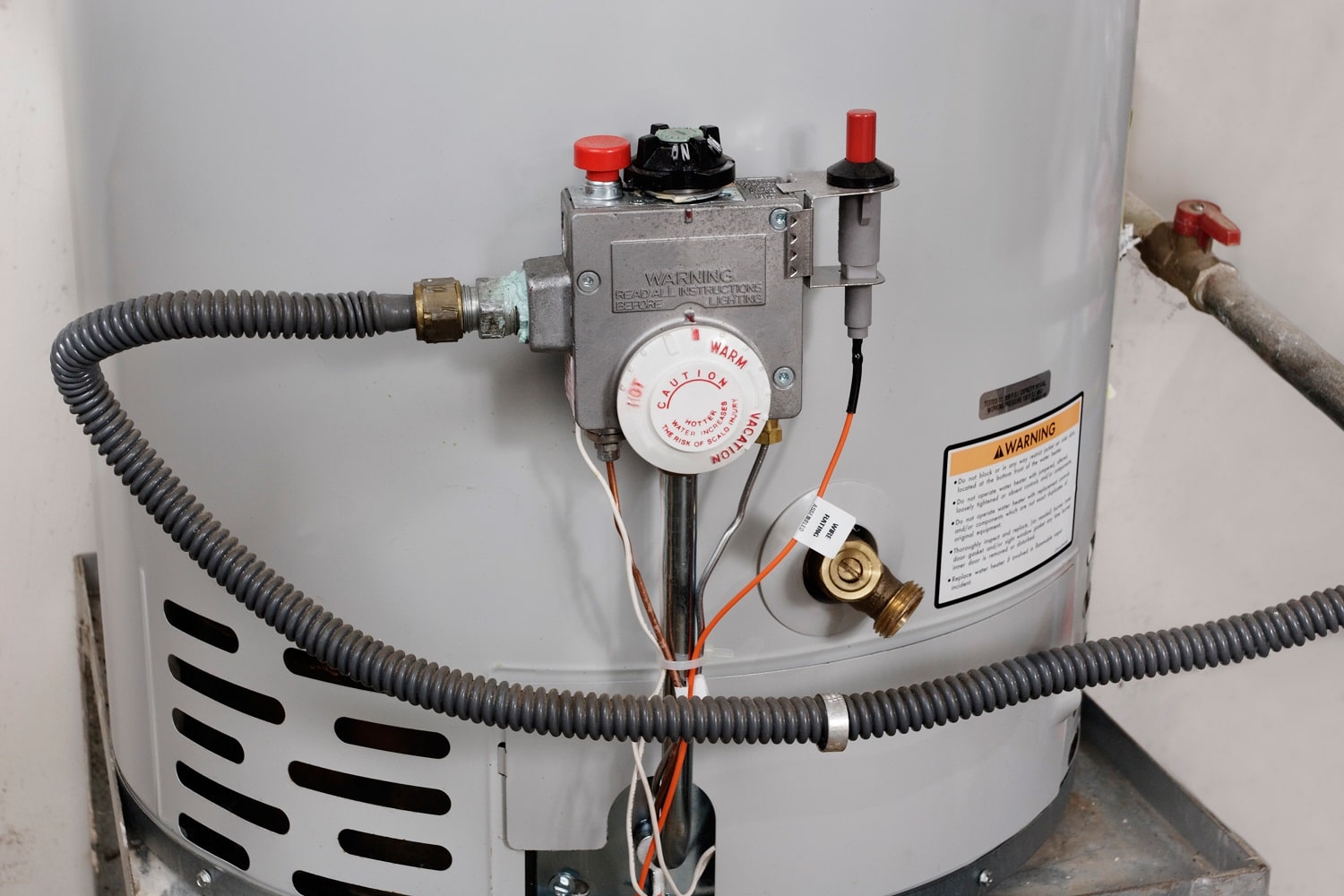
Now that you have all the information and details about tankless and storage water heaters, it’s decision time. There are a few other factors to consider specifically though before you make the final decision.
Flow rate
Flow rate refers to the gallons per minute of hot water that appliances and fixtures in your home use. Typical flow rates for appliances and fixtures are:
– Bathroom faucet: 0.5 – 1.5 GPM
– Kitchen faucet: 3.0 – 7.0 GPM
– Shower: 1.0 – 2.0 GPM
– Dishwasher: 1.0 – 2.5 GPM
– Laundry: 1.5 – 3.0 GPM
Adding the amounts together to find the total GPM for your household will help when choosing the necessary flow rate of your heater. Keep in mind a tankless water heater can provide between 4-8 gallons per minute. 4 gallons per minute will typically run fine when supplying both a shower and one other appliance.
Energy-efficiency
The Energy Factor (EF) of an appliance is what will determine the energy efficiency of the appliance. How well the water is heated, any standby heat loss and cycling loss are all determining factors. The higher the EF rating, the more efficient the unit is. A good heater will heat the water quickly, have minimal standby loss and lose less heat as water is circulated through the tank.
Energy efficiency is measured by the standby loss of a heater—the higher the rating, the better the energy efficiency. A tankless water heater will use 30% less energy and have a rating of 0.82 or higher. A gas storage tank, with higher insulation and venting, will have a rating of 0.67 or higher.
Cost
Cost considerations should include everything from the purchase, installation, maintenance, fuel and general use. A tankless heater will cost more upfront, but the payback will be higher than that of a traditional water heater. That being said, the wait time is longer, so consider how long you plan on staying in your home. A tankless unit is great if you are staying in your home long-term but less so if you plan to sell. According to Energystar.gov, throughout a tankless unit’s lifespan, it’ll save up to $1,800. A storage-tank water heater, over its lifespan, will save up to $500.
While electric fuel types are less expensive upfront, long-term savings are better with gas fuel since it is cheaper than electricity.
Hot water supply and demand
Choosing the right size for a water heater is a dual matter of both physical space, as well as hot water demand. A tankless unit is much smaller and compact, meaning it can easily be mounted on a wall. This makes them ideal for smaller homes or apartments where space is important. An outdoor tankless water heater can also be mounted outside of a home. A small unit for a large family, however, may not be so ideal if water demand becomes an issue.
Storage water tanks can hold more water and are readily heated, though they do take up more space. According to Home Advisor, a family of 1-2 will need a tank size between 26-36 gallons. A family of 3-5 though, will need between 46-56 gallons in a tank. The more water the tank holds, the bigger it will be. For smaller families with less space, if the budget is right, then tankless may be the best option.

Find a RenovationFind Certified plumber in your city!
| Alberta | British Columbia | Saskatchewan |
| Best Edmonton Plumbers | Best Kelowna Plumbers | Best Regina Plumbers |
| Best Calgary Plumbers | Best Vancouver Plumbers | Best Saskatoon Plumbers |
| Best Victoria Plumbers | ||
| Manitoba | Nova Scotia | Newfoundland |
| Best Winnipeg Plumbers | Best Halifax Plumbers | Best St. John’s Plumbers |
| Ontario | Quebec | New Brunswick |
| Best Toronto Plumbers | Best Montreal Plumbers | Best Fredericton Plumbers |
| Best Barrie Plumbers | Best Quebec City Plumbers | Best Moncton Plumbers |
| Best Hamilton Plumbers | Best Saint John Plumbers | |
| Best Kitchener Plumbers | ||
| Best London Plumbers | ||

